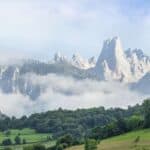Jammu and Kashmir, nestled amidst the majestic Himalayas, boasts a captivating natural landscape that is adorned with diverse and enchanting vegetation. The natural vegetation of Jammu and Kashmir is a testament to its ecological richness and unique biogeographic features.
Jammu and Kashmir have varied landscapes and weather conditions, which means it has many different areas where different plants and animals live. The region offers a tapestry of botanical wonders, from the lush green forests of Deodar and Chinar to the rugged alpine forests.
These forests look beautiful and have an essential job in balancing the environment. The forests help the people living nearby and attract nature lovers worldwide.
The Diverse Biogeographic Zones of Jammu and Kashmir
Jammu and Kashmir, with its varied topography and climatic conditions, encompasses diverse biogeographic zones, each characterized by unique ecological characteristics and vegetation. Let’s explore these zones in detail:
Western Himalayan Zone
The Western Himalayan Zone of Jammu and Kashmir is home to breathtaking landscapes and a remarkable variety of vegetation. This Himalayan zone consists of two main types of forests:
Subalpine Coniferous Forests
These forests are found at higher altitudes with spruce, fir, and pine trees. These trees are crucial for the area’s variety of flora and fauna since they can thrive in cold and snowy climates.
Temperate Deciduous Forests
Lower elevations in the Western Himalayan Zone are adorned with temperate deciduous forests. These forests consist of trees like oak, maple, chestnut, and walnut, which shed their leaves during winter.
Sub-Himalayan Zone
The Sub-Himalayan Zone of Jammu and Kashmir is characterized by a transition from the towering Himalayas to the plains. It encompasses the following distinct forest types:
Moist Tropical Deciduous Forests
Closer to the plains, the Sub-Himalayan Zone hosts moist tropical deciduous forests. These forests thrive in a relatively warmer and wetter climate and are rich in species like teak, sal, and bamboo, supporting diverse wildlife.
Subtropical Pine Forests
As we move towards the lower elevations, the Sub-Himalayan Zone is adorned with subtropical pine forests. These forests feature chir pine and blue pine, which are well-adapted to the region’s semi-arid conditions.
The diverse biogeographic zones of Jammu and Kashmir reflect the region’s unique ecological diversity, offering a glimpse into the remarkable range of natural vegetation that flourishes in this enchanting land.
The Majestic Forests of Jammu and Kashmir
These diverse forest ecosystems of J&K, including Deodar forests, Chinar forests, and Alpine forests, showcase the rich flora, fauna, and unique characteristics of natural vegetation of Jammu and Kashmir.
Deodar Forests
Deodar forests are characterized by their majestic and towering deodar cedar trees. These forests are predominantly found in the higher altitudes of Jammu and Kashmir. Deodar forests contribute significantly to the region’s biodiversity and play a crucial role in soil conservation and watershed management.
Flora and Fauna of Jammu and Kashmir
Numerous flora and fauna (plants and animals) are found in the Deodar forests. The plants include tall trees that stay green all year round and smaller plants like bushes, herbs, and pretty wildflowers that grow beneath the trees.
Fauna found in these forests includes mammals like the Himalayan black bear, musk deer, leopard, and numerous bird species.
You May Like to Read: Natural Vegetation and Wildlife
Chinar Forests
Chinar forests are notable for their magnificent Chinar trees, also known as the Oriental plane tree. These forests hold great significance in Jammu and Kashmir, culturally and ecologically.
Chinar forests are primarily found in the Kashmir Valley, where the tree is considered iconic and revered for its beauty.
Alpine Forests
The alpine forests of Jammu and Kashmir thrive in the high-altitude regions, often above the tree line. These forests exhibit unique features, such as stunted growth due to harsh climatic conditions.
They are adapted to withstand cold temperatures, strong winds, and a short growing season. Alpine forests harbor rare and endemic plant species that have adapted to the challenging environment.
Rare Species and Endemism Alpine
Forests are home to rare and endemic species found exclusively in these high-altitude regions. These species have evolved specific adaptations to survive in extreme conditions, such as cushion plants and alpine flowers.
The rare species in the alpine forests of Jammu and Kashmir make them unique and essential to protect.
Biodiversity and Conservation Efforts
Chinar forests support diverse biodiversity, including various tree species, shrubs, and ground flora. These forests are home to several birds, animals, and insects.
Due to their cultural and ecological importance, conservation efforts have been undertaken to protect and preserve Chinar forests, including measures to prevent illegal logging and promote sustainable practices.
It is crucial to conserve these forests to keep diverse plants and animals safe and maintain a healthy environment.
Rich Flora of Jammu and Kashmir
Medicinal Plants
Jammu and Kashmir boast a rich diversity of medicinal plants traditionally used for their healing properties. These plants hold significant importance in traditional medicine systems like Ayurveda and Unani.
They are utilized for various purposes, including treating ailments, producing herbal remedies, and supporting overall well-being.
Traditional and Contemporary Uses
The flora of Jammu and Kashmir offers a wide range of traditional and contemporary uses.
Traditional uses include herbal medicine, culinary purposes, and cultural rituals. In modern times, certain plants have applications in the pharmaceutical, cosmetic, and nutraceutical industries, contributing to local economies and healthcare practices.
Conservation Challenges
The rich flora of Jammu and Kashmir faces conservation challenges. The flora faces threats to their survival as their homes are being destroyed, these plants are being used too much, the climate is changing, and people are taking them in unsustainable ways.
Conserving medicinal plants requires efforts to protect their natural habitats, promote sustainable harvesting practices, and raise awareness about their importance.
Rare and Endangered Plant Species
Jammu and Kashmir have some scarce plants that are in danger of disappearing (Endangered). These species are often localized and have specific habitat requirements.
These plants are at risk because of habitat destruction, people selling them illegally, and the invasion of new plants, causing problems for their survival.
Threats and Conservation Initiatives
Rare and endangered plant species in Jammu and Kashmir face numerous threats. Habitat degradation due to urbanization, agriculture expansion, and infrastructure development poses a significant challenge.
The government takes several conservation measures to save these uncommon and endangered species, including establishing protected areas, habitat restoration, and collaborations with non-governmental organizations.
Ecological Importance
Rare and endangered plant species play a crucial role in maintaining ecological balance. They support environmental health, contribute to biodiversity, and give other organisms a place to live.
Protecting these species is essential for preserving the overall health and integrity of Jammu and Kashmir’s ecosystems.
The diverse flora of Jammu and Kashmir, including its medicinal plants, rare and endangered species, and their conservation challenges and initiatives, showcases the botanical richness and the need for sustainable practices to ensure their continued existence.
Fauna and Wildlife Sanctuaries
Mammals
Wildlife of Jammu and Kashmir includes two famous mammals:
Snow Leopard
Jammu and Kashmir is known for being home to the majestic snow leopard. This elusive and endangered species is adapted to the harsh mountainous terrain and is highly treasured for its rarity and beauty.
Through actions like habitat preservation and anti-poaching activities, efforts are being undertaken to conserve and safeguard this famous big cat.
Hangul (Kashmir Stag)
The Hangul, or Kashmir Stag, is a critically endangered species in the region. Known for its impressive antlers, the Hangul is endemic to Jammu and Kashmir.
Conservation activities aim to preserve this rare and attractive deer species by safeguarding its habitat, reducing poaching, and increasing public awareness of the issue.
Avifauna
Regional birds of J&K includes:
Western Tragopan
The Western Tragopan is a colorful and endangered bird species found in the forests of Jammu and Kashmir. Known for its striking plumage and elaborate courtship displays, this bird faces habitat loss and hunting threats.
Conservation efforts aim to safeguard its habitats and implement measures to reduce human-wildlife conflict.
Black-Necked Crane
The Black-necked Crane is a migratory bird species visiting Jammu and Kashmir during winter. These graceful cranes are considered sacred and hold cultural significance in the region.
Conservation initiatives focus on preserving their wetland habitats and minimizing disturbances to ensure their successful migration and breeding.
Wildlife Sanctuaries and Conservation Efforts
For the conservation of wildlife government has setup two wildlife sanctuaries in J&K these are:
Dachigam National Park
Located near Srinagar, Dachigam National Park is renowned for its biodiversity and serves as a protected area for various wildlife species including famous Kashmiri Stag (Hangul).
It is vital for the conservation of the Hangul (Kashmir Stag). Restoration of the habitat, anti-poaching measures, and community involvement are all part of conservation activities that support sustainable protection of this beautiful Park and Hangul.
Hemis National Park
Hemis National Park, which is located in Ladakh, is the most significant national Park in South Asia and is renowned for having a unique high-altitude environment.
Hemis national park is home to many wildlife species; one species is the snow leopard. Conservation efforts in this Park focus on habitat protection, scientific research, and community-based conservation initiatives.
Jammu and Kashmir’s fauna thrive in the region’s diverse ecosystems, including iconic mammals like the snow leopard and Hangul and avifauna such as the Western Tragopan and Black-necked Crane.
Creating wildlife sanctuaries and conservation steps within these sanctuaries are essential to safeguarding and preserving Jammu and Kashmir’s unique biodiversity.
Environmental Challenges and Conservation Measures
Environment of J&K faces challenges due to several reasons and needs to be addressed.
Deforestation and Illegal Logging
Ecosystems and biodiversity suffer from illegal logging and deforestation. The loss of forests disrupts habitats, leading to the decline of plant and animal species.
Besides, it can affect the delicate balance of ecosystems and result in the loss of vital ecosystem services like carbon sequestration and soil conservation.
Forest Conservation Programs
Various forest conservation programs have been implemented to address deforestation and illegal logging. These programs focus on sustainable forest management, reforestation initiatives, and community participation in conservation efforts.
They aim to protect and restore forests, promote responsible logging practices, and raise awareness about the importance of forest conservation.
Climate Change and Its Effects
Climate change adversely effect the environment one of its bad affect is:
Glacial Retreat and Water Resources
Climate change has led to the retreat of glaciers in Jammu and Kashmir. Glacial meltwater is essential to maintain the region’s rivers, lakes, and water supplies.
The loss of glaciers affects water availability, agriculture, and hydroelectric power generation, posing challenges to the local communities and ecosystems dependent on these resources.
Sustainable Practices and Adaptation Strategies
Sustainable practices and adaptation strategies are being pursued to mitigate the effects of climate change on the natural vegetation of Jammu and Kashmir.
These include encouraging renewable energy sources, carrying out water conservation measures, implementing climate-resilient agriculture practices, and creating early disaster warning systems.
The importance of spreading knowledge about climate change and its effects on regional populations is also emphasized.
Addressing deforestation, illegal logging, and climate change requires a combination of policy interventions, community engagement, and sustainable practices.
By implementing forest conservation programs, promoting responsible logging, and adopting adaptation strategies, Jammu and Kashmir can work towards preserving its ecosystems, protecting biodiversity, and building resilience in the face of environmental challenges.
Conclusion
Jammu and Kashmir is blessed with diverse and captivating natural vegetation. The region encompasses various biogeographic zones, each with unique characteristics and flora.
From the majestic Deodar forests to the iconic Chinar forests and the resilient Alpine forests, Jammu and Kashmir’s natural vegetation showcases a rich tapestry of biodiversity.
The area is home to iconic fauna like the snow leopard and Hangul and rare and endangered plant species. However, this natural heritage faces challenges such as deforestation, climate change, and illegal logging.
The natural vegetation and long-term sustainability of Jammu and Kashmir’s ecosystems depend heavily on conservation activities, which include sustainable practices and programs for protecting forests.
We must value and protect this remarkable treasure for future generations to enjoy and benefit from.





